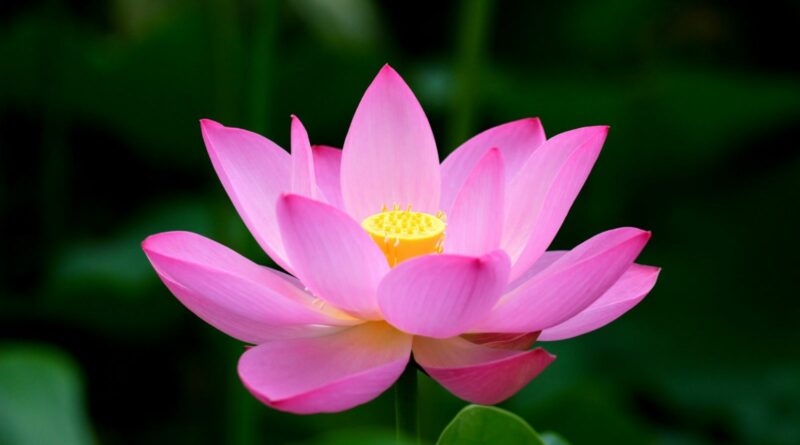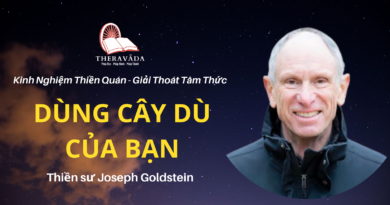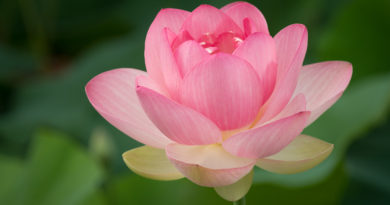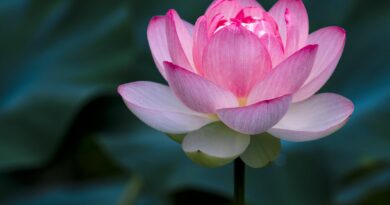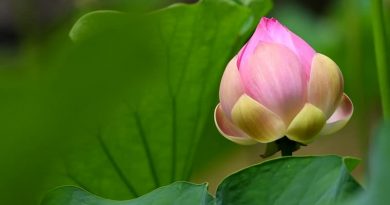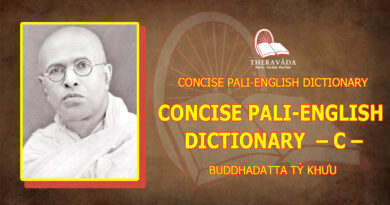DHAMMA RATANA – CHAPTER 10: HAPPINESS AND PLEASURABLE FEELING
DHAMMA RATANA – CHAPTER 10: HAPPINESS AND PLEASURABLE FEELING
Today’s Dhamma discourse is on the “Sukha Somanassa Sutta”. Sukha=happiness, somanassa=pleasurable feelings; sutta=explanation. In this sutta, Buddha explained how one can enjoy happiness and pleasurable feeling in this very life. If a monk (one striving for freedom from sufferings) is accustomed to the six factors, he can enjoy happiness and pleasurable feelings in this very life. If he continued to practise dhamma, he could eliminate asavo, that means he gains arahatta fruition (phala) where one’s mind is directed towards nibbana which is free from all sufferings.
This discourse is very appropriate to the dhamma listeners. The six factors are –
(1) To delight in dhamma
(2) To delight in meditation
(3) To delight in discarding immoral dhammas
(4) To delight in solitude
(5) To delight in place free from sufferings
(6) To delight in freedom from dhamma expanding the cycle of existence
(1) Delight in dhamma
There are various ways of enjoying oneself, such as enjoyment in the company of wife, husband. sons and daughters, enjoyment in playing and listening to music and dancing. Some find enjoyment in taking care of animals. I met a lady who enjoyed in fanning a pet dog on hot days. As for kings and emperors they have a great delight in possessing pomp and wealth and also in possession of elephants and horses. All these happiness and pleasure lead to sufferings in rounds of samsara. Therefore, they are the causes of old age, suffering and death.
However delight in Dhamma results in happiness and pleasurable feeling in this very life and also the attainment of nibbana in the subsequent existence. Of all the delights, one in dhamma is the most noble one as its effect is the attainment of nibbana which is free from all sufferings in the rounds of samsara. It is more evident in vipassana meditation. Reading and recitation of dhamma scriptures and also teaching the three Tipitakas (baskets) are regarded as delight in dhamma. Lecturer monks feel that the day is incomplete if they have not to lecture. Student-monks also are unhappy when they cannot study. That is how monks delight in dhamma. Some even shed tears while reciting or chanting parittas and gathas (verses from the scriptures). This kind of tear is cold tear for dhamma due to the delight in dhamma.
A yogi who has reached Udayabbaya Nana Stage, practised in a secluded place and comprehended the nature of becoming and dissolution of nama and rupa. Whereupon vipassana piti and sukha developed and he was in a delightful state. The Buddha had remarked that leave alone a common worldling, not even a deva could enjoy such delight. Yogi with strong Udayabbaya Nana will remember their similar experiences. At the mature stage of Udayabbaya Nana after experiencing the pleasure of this happiness and joy, yogi exclaimed thus, “It is the great opportunity to be a human being in this very life. I’m quite certain, I’ll attain nibbana with this consciousness’. As a matter of fact, he has enjoyed the incomparable delight in dhamma. This bliss and weak joy is regarded also as a preliminary nibbana by the Lord. Though it is the cause for the attainment of nibbana (result), it is connoted as the result. In other words, the Buddha meant to say that one who has enjoyed such bliss and weak joy one day, will attain nibbana inevitably.
(2) Delight in Meditation
There are two ways of meditation; samatha (tranquility) meditation and vipassana (insight) meditation. Samatha meditation dispels nivarana (hindrance) and it result in happiness and pleasurable feelings in this very life, whereas vipassana meditation sends one to nibbana which is free from all sufferings. People delight in meritorious deeds according to their accustomed inclination in their past existences. Those with inclination towards giving dana and charity and are not greedy (a-lobha) usually delight in giving dana in this life too. They enjoy building pagodas and monasteries and in ordinations of monks.
Those with inclination towards the development of loving-kindness (a-dosa) in their past existences delight in observing moral conduct (sila) and also in undertaking duties such as helping old and sick ones, monks and yogi. A-dosa is metta, which manifests in the desire for happiness in oneself and in others too, and also in observing sila and not breaking the precepts. Some delight in sila and some in dana but not in vipassana meditation. However, those who have inclination towards development of wisdom and expelling moha (delusion) i.e. vipassana meditation in their past existences, delight in practising vipassana meditation. They usually do not enjoy dana and sila. Dana and sila are supporting factors for the happiness of deva realm and human abode, whereas samatha meditation is for Brahma realm. Vipassana meditation is the only way leading to nibbana. Listeners can make a choice. Though one may be reborn in the highest Brahma realm, his next destiny might be in apaya, since he had not practised vipassana meditation.
“Shining, shining in Brahma World, grunting, grunting in the sty of pigs”. That is the reason why samatha meditation is unreliable for the attainment of nibbana which is free from all sufferings. Happiness in deva world and human abode are free from sufferings for one existence, not for ever. Nibbana is the only one completely free from all sufferings. In fact practising yogi have explicit knowledge of the difference between samatha and vipassana meditation, thereupon they ardently contemplate vipassana meditation. At the beginning yogi may encounter with dukkha, however in the later stages, he will have happiness. At first because of pain, aches, numbness and so on, yogi may be depressed. therefore sayadaw has to deliver frequently, dhamma discourse on the benefits of vipassana meditation. “The enjoyment of worldly pleasure undoubtedly ends in unhappiness and sufferings, if not in this very life, it will manifest in subsequent existences. That means suffering in apaya,” said the Buddha-would-be hermit.
The benefit of samatha meditation is jhana absorption whereas that of vipassana meditation is the attainment of nibbana. At the Nama-rupa pariccheda Nana Stage, yogi experiences dukkha to a certain extent. To control your body not to sway and to control your mind so that it may not wander, for an hour long sitting is dukkha, especially when concentrations is not strong enough. It will be the same at the Paccayaparigghaha Nana Stage. However, at the Sammasana Nana Stage, the worst one of all stages of insight, there is more pain, aches, numbness; giddiness, heaviness, swaying etc. Yogi has no clear idea of what he experienced although about ten days have gone by. He wants to go home as he has not gained dhamma, but only aches, pain, etc:. After giving many lame excuses, he went home and said that he had not gained any dhamma.
He did not understand that these manifestations of dukkha is dhamma, since he has no knowledge of dhamma. Another way, the vivid manifestations of these dukkha vedana are to be contemplated, therefore they must be taken as dhamma and objects of noting. Noting dukkha vedana is vedanan nupassana i.e. contemplation of vedana. The Buddha reminded to note vedana. Thinking that he has not gained dhamma, yogi is reluctant to go up to the meditation hall. Upon hearing the bell to practice he said, “Here goes the bell. I have to go and sit and suffer for an hour”.
At the mature Udayabbaya Nana Stage, yogi experiences happiness instead of pain, aches, numbness giddiness and so on. At the Sammasana Nana Stage, the meditation instructor has to encourage yogi telling “You’ll have less pain and more pleasure in the next stage of insight”. This is not just words of comfort but a truth. If yogi notes respectfully, attentively and objectively, he will progress in a short time. Some yogi used to complain, “I practise vipassana meditation to gain sukha, however it is all pain, dukkha. I’m nearly dying”. As one suffers more pain one has to strive more and note successively, not sporadically. Thence dhamma progresses swiftly. If noting is sporadic and shifting here and there i.e. noting rising and falling for a while and then change to “sitting”, “sitting , there is no hope for progress in dhamma even though a month has passed. One must practise without sparing one self and life.
Motto: Disregard your body and life but must not spare yourself
Certainly you are not going to die. Practise with utmost physical and mental diligence. Thereupon, it is evident that nibbana will be attained. If you note and overcome whatever dukkha manifests, you will gain dhamma.
Motto: Must overcome whatever sufferings may manifest, when you are contemplating
Not long after sitting, yogi experiences pain, aches, numbness, giddiness, swaying, heaviness and so on. To him sensations of pain and aches appear to come from the bone, bone marrows and nerves. When concentration is deepened, sensation of pain is exaggerated. In fact it is not that strong. After days of practice, there is less pain and more progress in dhamma. Some yogi take only a day and a night to overcome this stage. At the Udayabbaya Nana Stage, in contrast to the Sammasana Nana Stage, pain is no more distinct. Yogi feels both physical and mental buoyancy and remarked. “Though I’m swaying, it is very light. As if my body is pumped with air and it is just like a floating leaf’. At Sammasana Nana Stage he felt heaviness in his body. Yogi sways in both Sammasana Nana Stage and Udayabbaya Nana Stage; however the sensation is different. He delights buoyant swaying at the Udayabbaya Nana Stage and thus hinders the progress in dhamma.
Meditation instructor has to remind him to note “swaying” “swaying” and not to develop an inclination towards it since it is an obstruction to the progress of dhamma. Yogi experiences both physical and mental buoyancy and subtleness. The instructor keeps a close watch on how the yogi reports, gentleness in his action and walking movements Thereupon he can assess the improvement in dhamma and also whether yogi is at the Sammasana or the Udayabbaya Nana Stage. If yogi’s report is still on pain and aches for several days, he is certainly at the Sammasana Nana Stage. He has not progressed.
Yogi is also bodily and mentally pliable and when he reports, he is very mindful and subtle. Those who used to change 3 or 4 times in one sitting, now do not change their posture during the whole sitting. Furthermore those who could sit without changing for an hour, now can sit for 2,3, and 4 hours.
He is also physically and mentally proficient. The arising of object of noting and the noting seem to be effortless and go on of its own accord. There is no need to control his body or mind. Moreover he feels physical and mental calm and peace. His body is still and erect just like a doll and his conscious mind also continues to note spontaneously. He is happy both physically and mentally. Now yogi enjoys vipassana bliss incomparable to any other joy. At the beginning of meditation practice, it is painful or dukkha, however in the middle yogi finds happiness or sukha. Thus he delights in vipassana meditation. Since samatha meditation is for happiness in just one existence, it is not dependable. As vipassana meditation is the most reliable, we must delight in it.
(3) Delight in discarding immoral dhamma.
One with moral dhamma usually does not want to associate with persons who indulge in immoral deeds. Nor he wants to hear about unwholesome circumstances. Practisingin a meditation centre is, in a way eliminating delusion, greed and anger, the bases for immoral dhamma. When unwholesome consciousness such as raga and lobha arise, it is to be eliminated by contemplating asubha kammatthana, the meditation- subjects of impurities dosa or anger can be eradicated by metta- bhavana loving – kindness meditation. Vipassana meditation is the best way of dispelling moha-ignorance or delusion.
Motto: When raga arises dispel by contemplating the body as loathesome and impure (asubha)
Raga arises when you perceive the loathesome body (asubha) as a desirous one (subha). Attachment to oneself or others’ will not arise if you contemplate the meditation-subjects of impurities.
Motto: When dosa arises expel it by loving-kindness meditation
Once you develop loving-kindness, dosa or anger will disappear. Loving-kindness, and anger are antithesis. As soon as you contemplate metta bhavana dosa vanishes.
Motto: When moha arises annihilate it by vipassana meditation
When moha arises one is deluded and could not even differentiate nama and rupa. Delusion is to be dispelled by panna bhavana which is vipassana meditation. Hence it means to contemplate insight meditation.
4. Delight in solitude
To enjoy happiness and pleasurable feelings in this very life and to attain nibbana in the subsequent existences, dwell in a solitary place. If you want to be liberated from asavo dhamma (defilements) practise in solitude. Is it delightful to
stay in a meditation centre undisturbed by sensual sight, sound, smell, music, dance and so on? So to stay in a meditation centre is the same as staying in solitude. You can see clearly how happy are yogi practising in a meditation centre as it is peaceful and quiet. There are three kinds of seclusion (viveka).
(1) kaya viveka-physical seclusion
(2) Citta viveka-mental seclusion and
(3) Upadhi viveka- complete or utter seclusion
(1) Physical seclusion
Yogi comes to a meditation centre, leaving his family, relatives, friends and other business behind. Since you have no concern about them, your movement and behaviour be come gentle and calm. It is more so when you meditate in the forest, away from the commotion of life. When you are with friends and relatives or have company, you have to have consideration for them, for example, when you say or do something, you are worried whether the words or the action might annoy your friends. You gain physical seclusion if you practise in the forest.
(2) Mental seclusion
According to the scriptures mental seclusion is the attainment of jhana absorption. Those who practise samatha mediating gain jhana absorption which expels (nivarana) hindrances such as lobha, dosa, moha, conceit. Hence their mind is calm and clean, that is mental seclusion. Mental seclusion promotes more happiness than physical seclusion.
As for vipassana meditation, mental seclusion is not readily gained at the beginning of practice in the meditation centre. After practising for several days yogi’s mind wanders no more; noting mind settles on the object of noting precisely. With proficient concentration, yogi can note successively and thereupon lobha, dosa and moha have no opportunity to arise. This annihilation of lobha ,dosa and moha is mental seclusion. Yogi who had passed Udayabbaya Nana Stage experiences with mental seclusion more vividly.
Both samatha meditators and vipassana meditators gain physical seclusion when they leave their family and enter a meditation centre. Samatha meditators gain mental seclusion when they attain jhana absorption whereas vipassana meditation gain mental seclusion where the concentration is mature and noting is precise and objective. Whereupon there is no chance for the development of nivarana (hindrances).
(3) Utter or complete seclusion
Samatha meditators after gaining concentration absorption (jhana sampatti) switch over to vipassana meditation and attain nibbana. The realisation of nibbana through arahatta magga and phala is regarded as utter seclusion. Vipassana meditation, at the Sankharupekkha Nana Stage, experiences more distinctly the spontaneous arising of object of noting and the noting mind. Hence he needs no effort to note, as the Sankharupekkha Nana Stage is well-known for “the equilibrium of happiness and suffering”. Thereupon his mind is calm and peaceful that is mental seclusion. By virtue of repetitive and continuous contemplation, yogis progress through the stages of insight. On the maturation and fulfillment of vipassana Nana (insight knowledge) he realizes nibbana after attaining Sotapanna magga and phala for once. Thus he is liberated from rounds of sufferings in apaya. This is how a vipassana meditator enjoys utter seclusion and become a sotapan – stream-winner.
One who realizes nibbana after attaining Sakadagami magga and phala is nearly free from repetitive sufferings of old age, sickness and anxieties in the six realms of Deva and human abode. He returns to the realm of Deva and human abode for once only – once-returner. One who realizes nibbana through anagami magga and phala is completely free from sufferings of kama sensuous sphere, such as old age, sickness and death. Thus he develops upadhi viveka-non-returner. Those who realize nibbana with arahatta magga and phala are completely free from the sufferings of 31 planes and establish utter or complete seclusion-Arahat, the Noble One.
Through three types of seclusions one has the opportunity to enjoy happiness. Mental seclusion provides happiness more than physical seclusion. Utter seclusion prompts happiness of nibbana more than mental seclusion. The three seclusions have reciprocal effect. Because of physical seclusion one can establish mental seclusion. Utter seclusion is established due to mental seclusion. For these reasons one has just to establish physical seclusion, then mental seclusion. The practising yogi have already established physical seclusion and even some of them have developed menial seclusion. It is, therefore, of utmost importance, to endeavour to gain utter seclusion.
(5) Delight in emancipation of suffering.
One is emancipated from suffering (a) when be attains nibbana and (b) when he attains arahatta phala. In this case i.e. No. (5) it is to take delight in the arahatta phala which is free from suffering. One should have a disposition to take delight in arahatta phala so as to live with happiness and pleasurable feeling in this very life and to attain nibbana in subsequent existences. In other words, one should practise satipatthana vipassana meditation which is the only way to arahatta phala, freedom from all sufferings.
(6) Delight in freedom from dhamma propagating the cycle of existence
Nibbana is the only place free from dhamma propagating the cycle of existence. What are these dhamma? Tanha (craving), Mana (conceit or pride) and Ditthi (erroneous view) the three papanca (expansion of the world) dhammas. A greedy person has no contentment He is never satisfied with what he has and wishes to have more and more , and better and better. Due to his craving and greediness, he is liable to commit any misdeeds, legal or illegible. Furthermore he could not gain dhamma. Without the knowledge of good deeds and bad deeds and their consequences, there is no checking for a greedy man who make mistakes after mistakes. That is how the world is expanded, i.e. creating sufferings after sufferings. Is it happiness or suffering to go round the cycle of existence? That is why craving is the cause of propagation of cycle of existence.
Erroneous view also is one of the propagating dhamma. Because of erroneous views, one develops attachment to wrong thoughts and ideas. That is the reason. why one should delight in the attainment of nibbana, so as to have happiness and pleasurable feelings in this very life and also to gain arahatta phala in subsequent existences. Even one with certain development of parami could not gain noble dhamma if he delights in diffuseness of the world.
Ashin Anuroddha, holder of highest designation in possession of divine-eye, took admonishment from Ashin Sariputtara and went to the forest to practise dhamma.
Inspite of fifteen days of strenuous practice he did not gain dhamma. The reason was his delight in diffuseness of 1000 universe, which he saw with his divine eyes. He became weary and took rest under a shady bamboo grove. There he thought up ideas. Lord Buddha knew his seven thoughts and came to him as swift as the stretching of a bending arm. The Lord then said, “Oh! my good son, are you not thinking of these seven ideas?’ “Yes, your Lord” replied Ashin Anuroddha. “These seven ideas are certainly related to dhamma, however there is one more factor for you to gain dhamma”, said the Buddha and continued to admonish Ashin Anuroddha, “My good son, four magga, four phala and nibbana, altogether making nine dhammas are not to be attained by one who delights in expansion of phenomena, like you. These nine dhammas are for one who delights in non-diffuseness. It is not for him who delights in worldliness.” The Buddha returned after giving Ashin Anuroddha instruction on meditation. The latter meditated according to the Buddha’s instruction and gained arahatship in a short time. This is due to his delight in non-diffuseness of the world.
Motto: One delights in diffuseness, craving and pride will never gain dhamma.
One delights in non-diffuseness and contemplation will gain dhamma.
It is the dhamma (magga, phala and nibbana) for one who delights in non-diffuseness and contemplation with mind directed towards nibbana. In other words it is to practise mindfulness meditation with directed attention to nibbana.
After listening to this dhamma discourse on “Sukha Somanassa Sutta”, may you all be able to practise in accordance to the Buddha’s instruction. With diligent contemplation, may you all immediately realize your most aspired Nibbana, which is free from all sufferings, by practising with ease.

